The planting method and Propagation of Flowers-Carnation
Carnation is native to southern Europe, the Mediterranean coast to India. Like cool, not fire-resistant, can bear a certain degree of low temperature. The suitable temperature for growth is 15-20 ℃. Like dry and sunny environment. Like fertilizer, it is suitable for slightly clayey soil with good drainage, rich humus and slightly acidic. All right, I'll solve the problem of how to raise carnations for you right away:
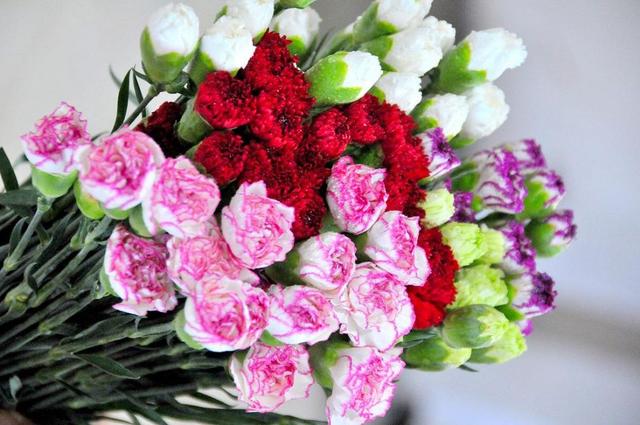
1. Environmental requirements for carnation culture.
Soil for carnation culture:
Soil or medium is the place where plant roots move. It is very important for carnation cultivation to create a loose and breathable rhizosphere environment with a certain ability to preserve fertilizer and water. Carnation is a herbaceous flower with root system, and its roots like to grow in loose, fertile and well-ventilated soil or medium. The best soil for growing carnations is sandy loam.
Soil ventilation gap accounts for about 30% of the most ideal, viscous and silted soil is not conducive to the growth of carnations, it needs to be improved, its core is to coordinate the relationship between solid, liquid and gas in the soil. The most effective way is to apply a large number of fully fermented crude organic matter, such as fully fermented leaves, shredded rice straw, sawdust, bark and so on. These crude organic compounds contain almost no organic nitrogen compounds, but mainly composed of polysaccharides.
The pH value of soil is another important parameter in its chemical properties. The pH value of soil suitable for carnation growth is 5.6-6.4, that is, slightly acidic. Alkaline soils with pH values greater than 7 are often prone to insoluble trace elements such as iron, manganese, zinc and boron, resulting in physiological obstacles. Acidic soils with pH less than 5 are easy to cause poor root growth and affect the absorption of fertilizer and water.
The temperature of carnation culture:
Carnations like wet, warm and cool climate, avoid severe cold and heat, and the suitable temperature is 15-28 degrees Celsius. When the temperature is below 10 degrees Celsius, the growth is stagnant; when the temperature is higher than 30 degrees Celsius, the growth is inhibited. In order to keep the temperature above 15 ℃ at night in winter, the doors and windows should be sealed and opened during the day for full ventilation, heat preservation with double film, or proper heating (electric heating wire, etc.). In summer, in addition to variety selection, shading and blackening the net, or spray cooling and other measures are effective management.
The light of carnation culture:
Carnations are sun-neutral flowers and plants, but they require high light intensity and can only grow well if there is enough sunshine. Carnations bloom for a long time, with each flower blooming for as long as 15 to 25 days. The main florescence of open field cultivation is from May to June and from September to October.
2. Fertilizer and water management of carnation culture.
The seedlings were watered immediately after planting to make the roots in close contact with the soil and improve the survival rate after planting. Avoid high temperature, high humidity and stagnant water, otherwise, it is easy to cause stem rot and lead to dead seedlings. However, growth and development will be affected or inhibited when it is too dry. The stem rot disease is mild when the growth is vigorous from September to October (about 15 ℃), and the temperature difference is large from November to March. If there is a lot of water, the bud of the large wheel variety is easy to crack.
It should be watered in the morning and evening in summer and noon in winter. Watering at high temperature or freezing will hurt the roots and reduce or inhibit vitality. As long as transplanting survives, soil drying has little effect, and its growth and development can be restored as long as watering. When the branch grows to 10 cm inch, control the water drought, promote the root to root down (3-4 weeks). In summer, it should be watered at night to promote stem extension.
Carnations belong to shallow root plants, so they should be fertilized thin and diligently. That is, use dilute dung water, rapeseed cake water or nitrogen, phosphorus, potassium, and calcium, magnesium liquid fertilizer. The amount of fertilizer application should be increased during the rapid growth period of plants from March to April and from September to October. Before and after opening the net, rapeseed cake, bone meal or quick-acting compound fertilizer should be applied once in combination with watering.
In the middle and later period, it is suitable to use phosphorus and potash fertilizer. After the bud is formed, foliar fertilizer is sprayed once a week, that is, 0.2% UV 0.3% potassium dihydrogen phosphate, to enhance the hardness of the stem. The amount of fertilizer absorbed by different varieties was different, and the general rule was potassium > nitrogen > alumina > phosphorus pentoxide > magnesium oxide. Potassium nitrate, ammonium sulfate and borax are all soluble in water and have obvious effect when used as liquid fertilizer.
3. Pot conservation of carnation culture
(1) obtaining high quality seedlings
The propagation of carnations can be done by cutting, but in order to obtain good varieties or high-quality seedlings to ensure the acquisition of high-quality finished flowers, it is a good choice to purchase seedlings from seedling merchants with good reputation. Generally speaking, cuttings can be planted in pots all year round, but if they are planted in autumn, the growth time will be longer. It will blossom from April to May next year when it comes to potting from August to September.
(2) specifications of flowerpots
Choose 9cm or 10cm flowerpots so that the finished flowers are suitable for sale on the market.
(3) cultivation substrate
Use high quality potted soil, pH between 6 to 7, imported peat mixed with 10% sand. The matrix needs to be sterilized. Add chemicals to prevent root rot in the soil before potting.
(4) watering
The soil needs to maintain sufficient moisture. To avoid irregular watering, regular watering is very important to prevent the necrosis of the lower leaves.
(5) temperature control
During the first 3-4 weeks of seedling planting, the temperature was maintained at about 12 ℃, and then dropped to 6 ℃. Temperature control and water supply should be regular according to light conditions. Proper ventilation is important, but sharp fluctuations in temperature should be avoided.
(6) cultivation and management
In the first few weeks of cultivation, flowerpots can lean against one pot, but should be opened at intervals of 2 to 3 centimeters after a few weeks. In principle, seedlings do not need to be coring, and most plants will produce enough branches. Only those seedlings that bud too fast need to pick the heart.
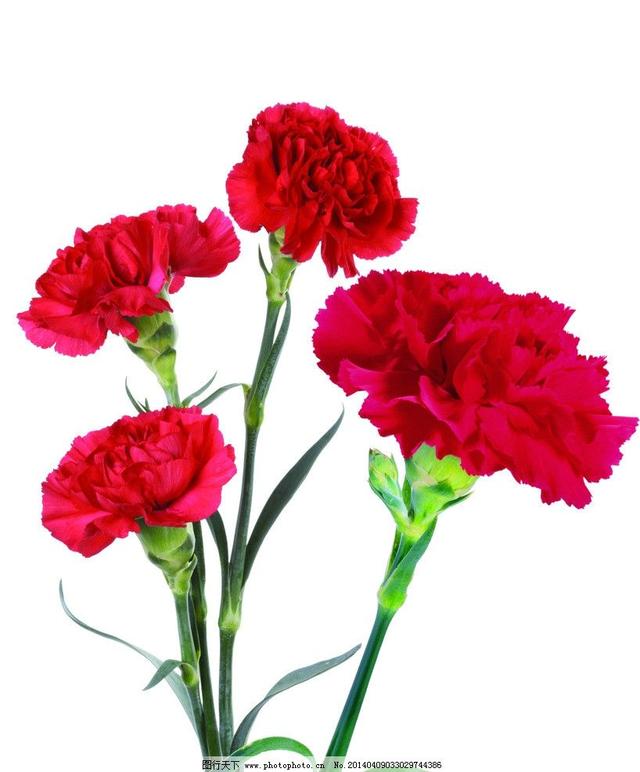
4. Breeding methods of carnation culture.
Carnation can be propagated by sowing, cutting, tissue culture and other methods.
(1) Cuttage propagation of carnation culture.
The cuttings can be carried out in the greenhouse from January to February, and the side branches about the length of 10cm on the strong mother plant are selected as cuttings. The matrix can be made by mixing 70% culture soil with 30% plant ash. After the cuttings were defoliated, the cuttings were immersed in water to absorb enough water, and then 1Accord 2 was inserted into the substrate. The indoor temperature should be kept at 10: 15 ℃, the light could be seen after 2 weeks of shading, and it could be transplanted one month after rooting. During this period, keep the soil moist and not too wet.
(2) sowing and propagation of carnation culture
The main method of sowing and propagation is autumn sowing, the optimum temperature for seedling emergence is about 25 ℃, watering and moisturizing after sowing, and seedlings can emerge after 10 days. Transplantation will be carried out when 2-3 true leaves are grown.
(3) tissue culture and propagation of carnations.
The main method of sowing and propagation is autumn sowing, the optimum temperature for seedling emergence is about 25 ℃, watering and moisturizing after sowing, and seedlings can emerge after 10 days. Transplantation will be carried out when 2-3 true leaves are grown.
5. Matters needing attention in carnation culture
(1) it should be noted that carnations should not be fertilized with thick fertilizer. Do not splash the fertilizer on the leaves and stems when applying fertilizer. Do not apply fertilizer when the temperature is high or low.
(2) the watering of carnations during the growth and development of carnations should be mastered to make the basin soil moist and dry; especially in the high temperature season in summer and low temperature in winter, carnations are in a semi-dormant state, and watering should be mastered to make the basin soil dry and prevent excessive watering to make the basin soil too wet and cause rotten roots.
(3) in the seedling stage, the coring should be carried out 1-2 times in time to promote the branching, the first time in 1 month after transplanting, leaving 5-6 basal nodes to remove the growing point. After the first coring, 3-5 lateral branches were produced, and then the second coring was carried out to promote the regeneration of branches, and each plant maintained 6-10 lateral branches. Picking the heart should be carried out before noon on a sunny day, but hold the section of the lower part on one hand and pinch off the top of the heart with the other hand. Carnation is easy to lodge, to stand up a pillar, or with lead wire, rope horizontal and vertical lattice, support to set up a grid, each plant only 1 grid. Square 5-6 layers, branches each 20-30 cm long, vertical binding to the support 1 time, with the plant growth, timely bud, bud, so as not to consume nutrients. The sprouting of the base is broken off in time, and the old and dead leaves are removed.
(4) Carnation is not cold-resistant, and its growth is in a stagnant semi-dormant state because the temperature is too low in winter. At this time, you should stop fertilizing, reduce watering, keep the basin soil dry, and place the pot plants in a place where you can get plenty of sunlight.
(5) the time from planting to flowering of carnations varies with temperature and light, ranging from 100 to 110 days to 150 days. If planted in May, it will begin to bloom in mid-late September, and will begin to bloom in June and December.
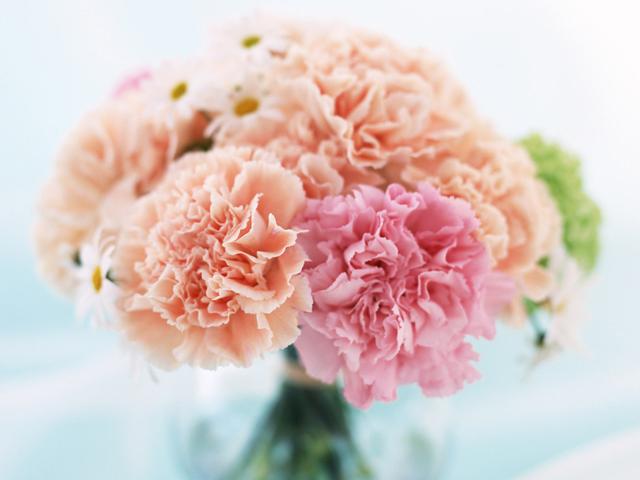
6. Disease and pest control of carnation culture
There are many diseases and insect pests in carnations, which often cause destructive harm. Common diseases are rust, gray mold, wilt, branch rot, spot disease, mosaic disease, common pests are red spiders, aphids, mole cricket, thrips and so on. Therefore, it is necessary to do a good job in soil disinfection and the prevention and control of diseases and insect pests, and regularly spray pesticides to prevent them when there are no diseases and insect pests.
1. Carnation branch rot
Symptoms: the disease mainly infects leaves, stems and buds. Most of the disease starts from the lower leaves, the light green water-stained small round spots on the leaves gradually expand into brown round or oval spots, and produce a black mildew layer on them, the disease part is twisted, and the leaves dry and droop without falling off.
Stem symptoms mostly occur in the branches and leaf bases. Disease spot grayish brown or dark brown, irregular, and finally produce black mildew on the disease spot, when the disease spot ring peeling branches, branch blight occurs.
When the bud is killed, there are round spots on the bud, with black mildew layer, and disease spots on the pedicel, which often cause the bud to die.
Prevention and control methods:
① selected disease-resistant varieties.
② removed the disabled body and destroyed it in time. Strengthen cultivation management, strong ventilation, light transmission, reduce mechanical operation damage, reduce or avoid spraying plants as far as possible.
③ cuttings were soaked in 1000 times potassium permanganate for 10 minutes, then washed with water and planted. The planting soil was disinfected with 1000 times of pentachloronitrobenzene.
④ spray control, spray the same amount of Bordeaux solution 4-5 times before onset (once every half a month), spray 75% Dysen zinc 500 times or 50% Dysenamine 1000 times after sprouting operation.
2. Carnation Fusarium wilt
Symptoms: carnations can occur in the whole process of growth and development. At the initial stage of the disease, the top tip of the plant grew slowly, and gradually withered and died. On young plants, one side of the plant often withered, while the other side grew normally, causing deformities. After the root died, the color of the aboveground leaves changed from dark green to light green, and finally to straw color. Peeling off the diseased stem, you can see the browning stripes in the vascular bundle, extending from the root to the upper part of the stem.
Prevention and control methods: select the land with good drainage to plant carnations, and do not continue cropping; when cutting seedlings, cuttings should be taken from the disease-free and robust mother plant, and the cuttage substrate should be disinfected to put an end to pathogen pollution; 50% carbendazim wettable powder or 50% carbendazim or 75% chlorothalonil 500 times solution was used to irrigate the soil near the diseased plant.
3. Carnation leaf spot
Symptoms: most of the disease starts from the lower lobe. At the initial stage, the leaves produce small round spots that are inconspicuous in the shape of light green water stains, and then expand into large spots of 3-5 mm, purple or brown, round, oval or semicircular, and gray-white in the center. Under wet conditions, a powdery black mildew layer grows on the disease spot. When dry, the disease is twisted. When the disease spot further expanded, the whole leaf withered and sagged and did not fall off for a long time. On the stem, the disease mostly occurs at the branch bifurcations and sprouting wounds, and the disease spot is grayish brown and irregularly long, followed by powdery black mold. When the disease spot surrounds the stem or branch, the upper branches and leaves wither and die.
On the bud, the spot is round, oval, water-stained at first, and then light brown to dark brown, with a black powdery mildew layer on the spot. In serious cases, the flowers can not open normally, or one side can not open normally, forming deformed flowers, which becomes one of the causes of calyx crack.
Prevention and treatment methods: select the land with good drainage to plant carnations and disinfect the soil; pick cuttings from healthy and disease-free plants, strictly eliminate diseased seedlings before planting, adopt protected cultivation, keep ventilation and light, avoid stagnant water on leaves, timely coring, and as far as possible in sunny days, to facilitate wound healing.
Select disease-resistant varieties, carry out crop rotation, and spray regularly. Use 1% Bordeaux solution, or 75% chlorothalonil wettable powder 500 times solution, or 75% mancozeb 500 times solution, or 50% topiramate wettable powder 500 times solution alternately, spray once every 2 weeks according to the severity of the disease, and have a better prevention and treatment effect.
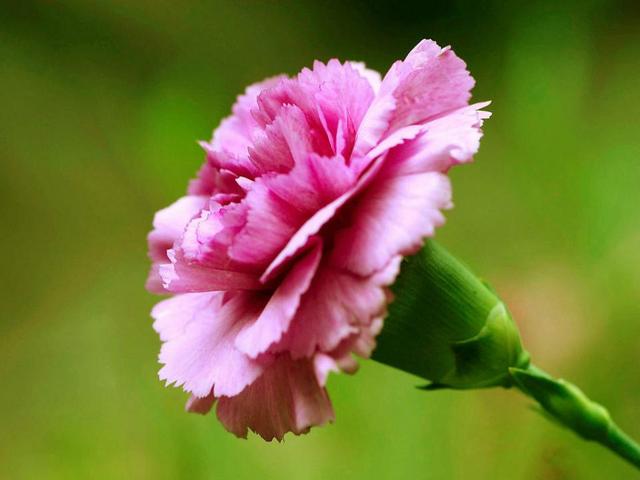
- Prev
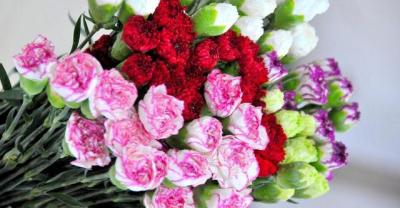
Planting method of potted red maple
Red maple is a variety of Acer maple, more varieties, its beautiful leaves, palm-shaped 5-7 cracks, red lasting, neat branches, clear hierarchy, light and unrestrained tree posture.
- Next
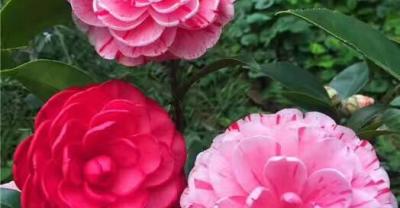
Planting method and Propagation of Flowers-- Dendrobium
Because Dendrobium is strong in nature and affable, it is known as "the flower of father". So how is Dendrobium cultured? Is there anything good about breeding?
Related
- Fuxing push coffee new agricultural production and marketing class: lack of small-scale processing plants
- Jujube rice field leisure farm deep ploughing Yilan for five years to create a space for organic food and play
- Nongyu Farm-A trial of organic papaya for brave women with advanced technology
- Four points for attention in the prevention and control of diseases and insect pests of edible fungi
- How to add nutrient solution to Edible Fungi
- Is there any good way to control edible fungus mites?
- Open Inoculation Technology of Edible Fungi
- Is there any clever way to use fertilizer for edible fungus in winter?
- What agents are used to kill the pathogens of edible fungi in the mushroom shed?
- Rapid drying of Edible Fungi

